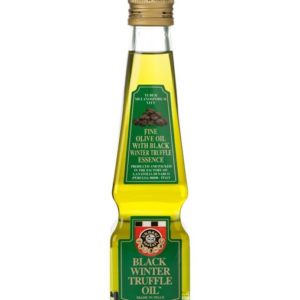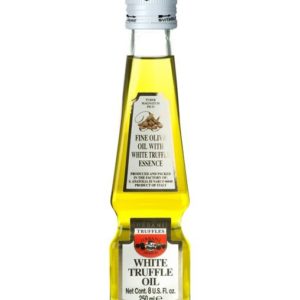Tuber aestivum, T. gibbosum, T. magnatum, T. melanosporum, T. texensis
Truffles have been found in Europe, Asia, North Africa, and North America, but only three species are commercially important. They live in close mycorrhizal association with the roots of specific trees. Their fruiting bodies grow underground.
The term “truffle” as commonly used refers to members of the genera Tuber and Terfezia. There are many other kinds of subterranean fungi, “false truffles,” which outwardly resemble the ones we eat. They are far more common than the ones that are collected for food, and some are poisonous.
Truffles are round, warty, and irregular in shape and vary from the size of a walnut to that of a man’s fist. The season for most truffles falls between September and May.
The mention of truffles conjures up images of the expensive French black truffle (Tuber melanosporum) from the Périgord region of southwest France, used in making pâté de foie gras, or the renowned odorous white truffle (Tuber magnatum) of Alba, in the Piedmont district of Italy.
Since the times of the Greeks and Romans these fungi have been used in Europe as delicacies, as aphrodisiacs, and as medicines. They are among the most expensive of the world’s natural foods, often commanding as much as $250 to $450 per pound.
Truffles are harvested in Europe with the aid of female pigs or truffle dogs, which are able to detect the strong smell of mature truffles underneath the surface of the ground. The female pig becomes excited when she sniffs a chemical that is similar to the male swine sex attractant. The use of pigs is risky, though, because of their natural tendency to eat any remotely edible thing. For this reason, dogs have been trained to dig into the ground wherever they find these odors, and they willingly exchange their truffle for a piece of bread and a pat on the head. Not a bad trade for the truffle hunter! Some truffle merchants dig for their prizes themselves when they see truffle flies hovering around the base of a tree. Once discovered, truffles can be collected in subsequent years at the same site.
The flavor of the truffle is directly related to its aroma. The chemicals necessary for the odor to develop are created only after the spores are mature enough for release, so they must be collected at the proper time or they will have little taste. This is the only sure indication that the mushrooms are ready to be harvested. That is why animals have proven to be the best means of assuring that the fungi collected will be flavorful.
Although commercial truffles are more plentiful in Europe than in America, fewer are found there now than in the past. A harvest of 2,200 tons was reported in l890. Three hundred tons were harvested in l914, but lately only 25 to 150 tons per year have been found. Truffles appear to have predictable life cycles. To ensure future production, appropriate tree seedlings are inoculated with truffle spores, and when the sapling tree is established, it is transplanted to the proper environment, usually a barren, rock-strewn calcific soil. It takes about seven years before the first truffle begins to grow. A bearing tree will produce for about fifteen to thirty years. For the European market to survive it is necessary to regularly replenish the population of truffle-bearing trees. Inoculated trees have been brought to North America, but it is too early to predict how successful these experiments will be.
Truffles are also found in North Africa, in the Middle East, and in North America. On the desert after rainfall, knowledgeable Middle Eastern people collect the “black kame,” Terfezia bouderi, and the “brown kame,” Terfezia claveryi. They prefer the darker ones. In Texas, Tuber texensis is collected, and in Oregon, the white Tuber gibbosum.
Gaining in popularity and comparing favorably with the Italian truffle, the Oregon truffle is harvested in sufficient quantity to support commercial sales. Although the Oregon truffle industry is in its infancy, it commands as much as $150 per pound for its truffles. James Beard claimed that the mature Oregon white truffle could be substituted for European varieties.
Originally found in California, the Oregon truffle grows in association with Douglas fir trees and is a major food source for many small rodents and other mammals. These underground fungi depend on animals to remove them from below the surface of the earth and to disperse the spores that result in the continuation of their species. Here is an example of complex ecology in which the tree, the fungus, and the animal depend on each other.
Collecting truffles requires training and experience. A small hand rake or cultivator is used to gently uncover the soil near the base of suspected host plants. As a rule, in the Northwest, these hosts are various kinds of conifer trees. Small freshly made holes at the bases of trees, which are not part of animal tunnels, are excellent indicators that animals have been digging for fungi.
To enjoy the wonderfulness of the variously described pleasure of dining on truffles, you must eat fresh, uncooked specimens shortly after they have been harvested. The strength of the truffle flavor decreases rapidly with time, and much of it is lost before some truffles reach the market. However, lovers of these earthly gems advise us that freshly harvested truffles can be purchased in advance from some local specialty stores. Wholesalers cover them with rice on restaurant serving trays in a refrigerated room as soon as they arrive via overnight air freight. The next day they are delivered to the store where your order was placed. When you spend as much money as will be needed for such culinary experiments, try to assure that you get truly fresh truffles.
The Italian white truffle is considered to be superior in smell and taste to the French black truffle. What does a truffle smell like? “A combination of musk, nuts, and ozone,” was one observer’s description. T. aestivum, a black summer truffle found in Germany, smelled to one observer like “a freshly opened can of creamed corn.” This black variety is not considered as choice as the other two European truffles. In Italy one Ping-Pong ball-sized Italian truffle has been said to have perfumed an entire apartment. The powerful pungency of this small tuber was such that some of the inhabitants were forced to flee!
Showing all 7 resultsSorted by price: low to high








